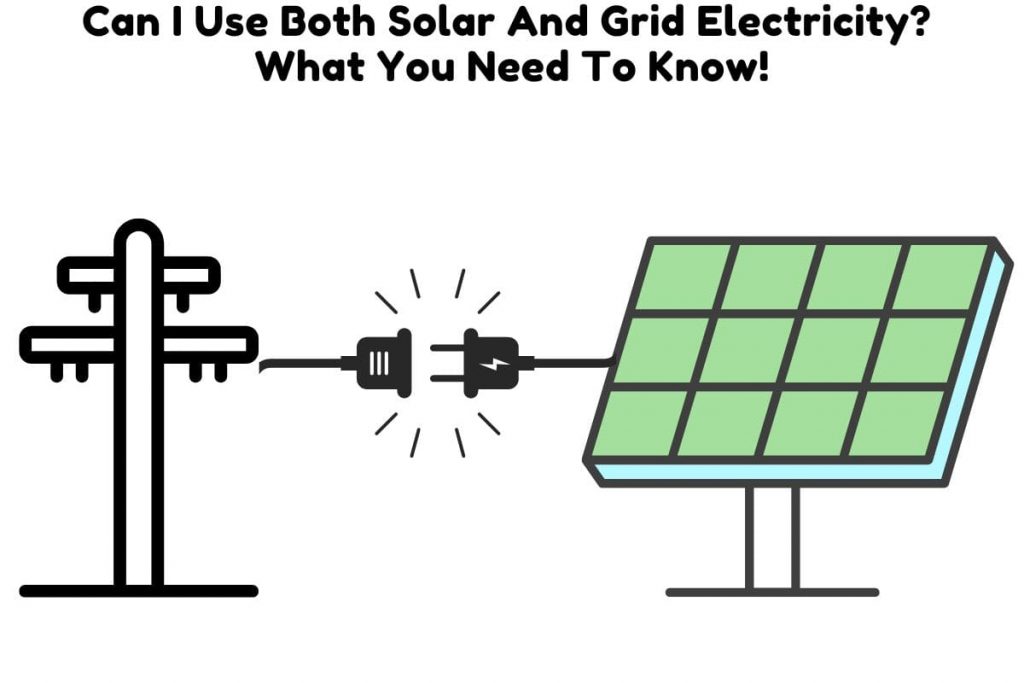Over two million solar panel systems have been installed in the U.S. Electricity prices have risen by about 4% per year in the last couple of years. Does that mean solar power should be used in place of grid-supplied electricity? Not quite.
Solar can be used together with grid electricity. Having both a solar system and a grid connection is an effective way to reduce energy costs and guarantee a consistent supply of electricity.
But how do they work together? In this article, we look at the specifics of a solar panel system that allows you to use both solar and grid-supplied electricity. How does it compare with having a system that is not connected to the grid?

How Do I Switch Between Solar And Mains?
Switching between solar and mains is automatic in a grid-tie system. There is no action necessary as the system switches on its own. When there is a sufficient supply of energy from the solar panels, the home or building will run on solar. If, however, there is not enough power from the solar panels, then grid-supplied electricity is used.
On a side note! If you’re in need of a reliable and high-performance portable solar panel, We strongly recommend the Jackery SolarSaga 100W Portable Solar Panel (Amazon Link).
With a high conversion efficiency and foldable design, this solar panel is easy to transport and set up, making it perfect for outdoor activities like camping, hiking, and RV trips.

The US solar cell technology used in this panel ensures that you get the most efficient and reliable solar charging possible.
There is also a 60W option that is more affordable (Amazon Link)
A grid-tie system is one of two main types of solar panel systems, the other being an off-grid. But what is the difference between a grid-tie and an off-grid system?
How grid-tie systems work
Grid-tie systems are also called grid-direct, utility-interactive, or even just grid connected. They all describe the same thing. A system that uses both solar energy and electricity supplied by a power utility company.
In a grid-tie system, electricity is drawn primarily from solar panels. There will be times when solar panels cannot supply electricity. For instance, solar panels do not generate electricity at night. They also generate less electricity on cloudy or rainy days.
When there isn’t enough electricity from the solar panels, the system simply switches to electricity from the power utility.
Components of a grid-tie system
A grid tie system will have solar panels, a grid-tie inverter, and a power meter. The grid-tie inverter is different from other types of inverters in that it shuts down the solar system in the event of a blackout.
Homeowners planning on exporting power to the grid also need to get a power meter or net meter. A net meter is different from a regular meter in that it measures electricity going in and out of the home. In that way it allows you to export power and get credits from your utility.
Pros of a grid-tie system
There are several advantages a grid-direct system has over an off-grid system.
- It is far much cheaper than an off-grid system. Typically, there are no batteries used in a grid-tie system. Batteries are the single most expensive component of a solar energy system.
- A grid-tie system guarantees a consistent supply of electricity. Even if the solar panels are not producing enough electricity, you can simply switch to your mains.
- Switching to solar can completely offset your electricity bill.
Cons of a grid-tie system
A grid tie system is not without its disadvantages, however.
- It does not work without grid-supplied electricity. If the grid goes down, then your inverter automatically shuts the solar system down as well.
Can Solar Battery Be Charged With Electricity?
Solar batteries can be directly charged with electricity drawn from the grid. This can be used as an alternative energy source if there is not enough power generated by the solar panels to fully charge the batteries.
Solar batteries are typically used in conjunction with solar panels in an off-grid system. There are, however, grid-tie systems that also have batteries. In this case, the batteries are there as a backup in case of a power outage.
It’s important to note that batteries take and store direct current (DC). This can be supplied by solar panels or any other energy source. Grid-supplied electricity on the other hand is alternate current (AC). Source
Charging batteries with grid-supplied electricity requires conversion of the AC electricity from the grid into DC electricity the batteries store. The most common way to do this is with an inverter charger. It converts AC to DC and allows you to charge a solar battery with grid-supplied electricity. Source
Do I Have To Switch To Go Off The Grid When I Switch To Solar Energy?
A grid-tie system is always connected to the grid. It allows switching between solar power and grid electricity. An off-grid system is an entirely different type of solar system. In an off-grid system, there is no connection to the grid.
It’s important not to confuse the two types of systems as this can lead to a very expensive mistake!
How off-grid systems work
Unlike grid-tied an off-grid system also provides electricity at night. There is no connection to a power utility so energy storage is necessary. An off-grid system also uses an off-grid inverter. These three characteristics are what make an off-grid system different from a grid tie.
Components of an off-grid system
An off-grid system always needs batteries for energy storage. Also, an off-grid inverter is different from a grid-tie in that it has no automatic shutdown feature. There is also a charge controller that manages voltage and current from the solar panels to the battery.
Pros of an off-grid system
Compared to grid-tie, the benefits of off-grid are:
- Complete independence from the grid. You do not have to worry about the grid going down.
- No electricity bills.
- Clean energy source.
Cons of an off-grid system
The main disadvantages are:
- Solar is intermittent. The sun does not always shine and when there is less sunshine, your solar output is affected.
- Might be a need to add a generator for backup.
Can You Have Solar And A Backup Generator?
A backup generator can be used to provide an additional power source. This can be to supplement solar if there is not enough energy from the solar system. Backup generators are typically fuel powered.
They are most commonly used with off-grid systems. As solar can be unreliable, having a generator gives added energy security on days when the solar system is not producing enough energy to charge the batteries.

